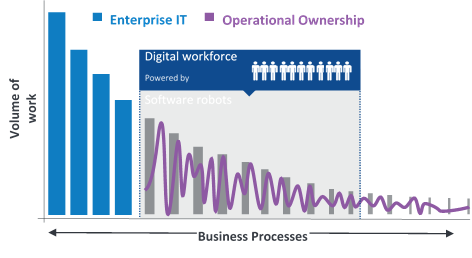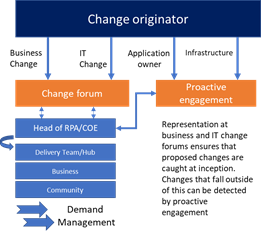Change Management within RPA
Change management is often the most difficult part of any software implementation, regardless of the technology. Many organisations struggle with; getting buy in from key stakeholders, encouraging adoption within their organisation, changes to staffing needs and training as well as changes in day to day operations.
Implementing RPA is no different, and the conventional change management topics above are covered and addressed by the Blue Prism Robotic Operating Model (ROM) and the implementation of an RPA Centre of excellence (COE). RPA also has another very important change management aspect focusing on IT and business change, here we consider these additional aspects.
Due to the nature of the processes that are automated using RPA – seen below in Figure 1, they reside in the “long tail of automation”. This means that they require a combination of both people and technology to perform these tasks. This is because the underlying technology can’t be adapted, evolved or developed at the speed at which the business needs to effect the changes of these volatile processes.

The long Tail of Automation
When we introduce RPA to a “long tail” process we need to consider that we are using a Digital Worker to automate a business process that is currently being performed by a human, using software (or a combination of different software) on a PC in an organisation. Therefore, there is a large dependency on the following:
- Business process changes
- Changes to the underlying software applications
- Scheduled changes and updates to the personal computer the operations are being performed on
- Changes in regulations or by laws.
These changes can pose a risk to RPA if they are not effectively controlled by a robust change management procedure.
Impact
Business Process Changes
Say, for example, that an organisation is using a digital worker to process mortgage applications. A recent change to the business process has not been articulated to the business owners of the automated processes, and as such no action has been taken to rectify the automated process.
There is now the potential for the automated processes to perform business tasks incorrectly or make incorrect business decisions which could result in:
- Potential loss of revenue.
- Reputational damage.
- Loss of customer.
- Increased number of cases required to be worked by a human.
Changes to Software Applications
Organisations will have a defined pipeline of software application enhancements to ensure that its workers have the correct performance level and features to enable them to perform their business tasks. Say, for example, that an organisation adds additional features and changes the layout of an application that a digital worker is interacting with - without the knowledge of the business owners of the automated processes.
If the changes to the application are significant enough it could result in the following:
- Digital worker stops functioning altogether and ceases to process cases.
- Digital worker continues to complete cases but uses the wrong fields/data.
- Digital worker stops processing a certain number of cases – triggering a larger number of cases to be worked by a human.
- Digital worker terminates more frequently.
- Failure to meet service, or process level, Service Level Agreement (SLA).
Changes to the digital worker's Desktop Settings
Organisations will have a defined pipeline of internal updates and patches that they implement to desktop infrastructure. This is to ensure that local policies, security access, antivirus and performance is maintained and upgraded across the organisation. If the digital worker's desktop infrastructure is part of the same group as other organisational users, they will also be applied to the digital worker’s desktop infrastructure, this could result in the following:
- Digital worker stops functioning altogether and ceases to process cases.
- Digital worker terminates more frequently.
- Failure to meet service or SLA.
Regulations and By-Law Changes
Organisations must react to changes in laws and regulations to ensure that they are compliant. If a Digital worker is affected by these changes but it has not been articulated to business owners of the automated processes no action has been taken to rectify the automated process.
There is now the potential for the automated processes to be performing actions that are against new regulations and law changes:
- Regulatory breaches, fines and even prosecution.
Having a well-defined RPA request for change process
Ensuring that the RPA capability (regardless of COE or federated model) has a change management process in which business owners of the automated processes can articulate upcoming business as usual changes to Blue Prism processes is critical for success. These changes can be managed and scheduled in the usual manner based on severity, impact, priority and resource availability and will flow through the relevant demand management pipeline into production.
The process should be:
- Well documented with clear SLA’s,required steps and owners.
- Clearly articulated and have high visibility to the business.
- Agile enough to implement changes as quickly as you would a human user, with minimal IT governance to slow down the process.
- Have pre-defined templates that will include:
- Process information.
- Impacted area.
- Change description and impact.
- Proposed solution.
- Mechanism in which change requests are monitored.
- Group inbox, SharePoint requests etc.
- Service management software.
Additional considerations – Change management communication and proactive engagement
To reduce the chance that changes to IT systems and group IT policies occur without the knowledge of the Blue Prism process owners and the CoE/hub - Blue Prism suggest that proactive engagement with the organisation change forums as well as application and IT policy owners as shown below.

Business and IT Change Forums
Ensure that the Blue Prism process owners/CoE and hub have visibility of proposed changes that may affect Blue Prism processes well ahead of the proposed rollout by:
- Representing RPA at the relevant change forum.
- Have visibility of the change pipeline and roadmap so that the change is caught at it’s inception and not when it is expected to be implemented:
- This enables you to proactively enhance RPA processes before changes land.
- Getting access to pre-prod versions of applications is advisable to assess impact on the digital workers prior to changes taking place.
- Cascade information between the RPA community.
Proactive Engagement and Tracking
Ensure that the RPA CoE has a proactive engagement model with application owners and IT governance/policy stakeholders so that any changes flow into the RPA capability:
- Ensure that group policy changes such as patches, updates to antivirus and screen locking policies are monitored proactively:
- Exclusion of Blue Prism run-time resources from automatic updates of these policies is advised - as long as risk and information security have been considered and consulted.
- Proactively engage with application owners as some changes may fall out of the organisational IT change governance forum:
- Ensure that application owners feed into the RPA capability within the organisation.
Keep a log of the existing business application landscape, screens utilised and prioritise highly utilised business applications to minimise impact.
Reactive Change Management
Ensuring that a proactive change management regime is in place is critical for a successful RPA implementation, however, it is likely that not all changes will be caught by the process. Due to the complex nature of organisations, changes commonly fall outside of an organisation’s IT and Business change management processes. For example, a non-business as usual IT “hot fix” may fall out of this process and could impact Blue Prism processes using that application.
Measures must be in place to ensure that the impact to Blue Prism processes and end user customers is minimal, Blue Prism recommend ensuring that the following are in place:
- Control Room triage process:
- First line investigation process based on information found in the Operational Handbook.
- Initial impact assessment.
- Severity classification for the type of escalation and triage required.
- RPA Incident Management and Business Continuity plans:
- Up to date communications and stakeholder information.
- Dedicated fix on fail team that deals with low effort bug fixes and changes (this will depend on the organisational design and size/need of the organisation).
- Dedicated Incident Management resource that triage the issue through to completion.
- Health check process that runs daily and investigates applications for changes in version numbers and key fields:
- This highlights issues earlier and enables the RPA team to be informed prior to commencing BAU ( Business as Usual) work.
Blue Prism’s Success Accelerator program combines various levels of mentorship and access to our Expert Services, Technology Ecosystem and Certified Partners based on the size and maturity of your digital workforce operations.